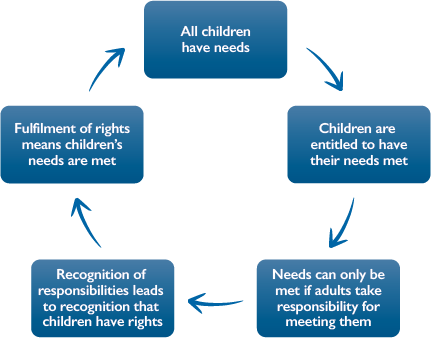3.4 Understanding children’s rights
The relationship between needs and rights
You have learned that children’s needs are universal. They apply to children in all socio-economic and cultural environments. It does not matter whether a child lives in sub-Saharan Africa, Brazil or Sweden, he or she has needs for a stable family life, adequate food, education, and respect for his or her abilities. You have also learned that the fulfilment of all needs is essential for children’s optimal health and development, and that they are mutually inter-dependent: none take precedence over another.
However, children’s needs cannot be met without adult support. Their youth, vulnerability and lack of power mean they are dependent on the adults who have responsibility for them. This places obligations on adults to create the necessary conditions that will ensure this happens.
Acceptance of the idea that adults have responsibilities or obligations to meet children’s needs has led the international community – all the governments of the world – to accept that children are entitled to have their needs met. In other words, children have rights.
Children’s rights
A right is often defined as a moral, ethical or legal entitlement to have something or to do something.
The realisation of rights means that rights become a reality. Although rights exist as legal entitlements, children still suffer from poverty, neglect and unequal access to education and health. It is not enough that governments and policy makers believe in rights. Children’s rights can only become a reality when they are accepted, promoted and implemented by everyone.
You will study the detail of children’s rights in Module 2
The difference between a need and a right is that a need describes the conditions required for children to thrive. A right is a recognition of the child’s entitlement, by virtue of being a child, to have that need fulfilled. This, in turn, places a specific obligation on adults at all levels of society to take the necessary action to ensure that those rights are implemented for every child. For example, action to protect the rights of the individual child, such as family life, access to health care or education, but also the consideration of public policies that potentially impact on children’s health and development – housing, transport and poverty. Figure 3.2 shows how children's rights are recognised and fulfilled.

Rights are based on the shared recognition of the conditions that are fundamental to children’s dignity, identity, health, development, and well-being. They are universal and applicable to every child in all contexts and cultures. All rights have equal importance. Everyone is equally entitled to human rights without any discrimination. Some rights can only be fulfilled if governments and other responsible people provide certain conditions – for example, health and education services. Other human rights are described as freedoms – for example freedom to choose your own religion. Everyone is entitled to enjoy their rights without undue interference.
Human rights are universal, inalienable and indivisible
Universal means that it applies to every person, regardless of the country of residence, or socio-economic status in society or community. A poor child living in Uganda, the child of a government worker living in Tanzania, and a rich child living in the United Kingdom all have the same rights.
Inalienable means that it cannot be taken away, except in some limited circumstances. For example, the right to freedom may be removed if a person is found guilty of a crime by a court of law. However, a person cannot be held indefinitely without trial.
Indivisible means that it is interdependent with other rights. Supporting the right to health will also mean that children are more able to benefit from their right to education. Similarly, if they are denied the right to health, they will not be able to learn effectively – so their right to education will be denied.
These principles are recognised as central to human rights (United Nations, n.d.).
Responding to children’s needs as they grow older
